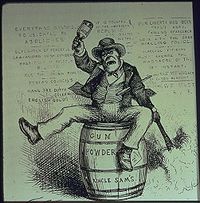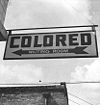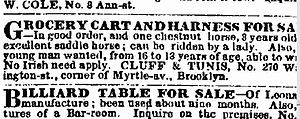- Anti-Irish sentiment
-
 American political cartoon by Thomas Nast titled "The Usual Irish Way of Doing Things", depicting a drunken Irishman lighting a powder keg and swinging a bottle. Published 1871-09-02 in Harper's Weekly.
American political cartoon by Thomas Nast titled "The Usual Irish Way of Doing Things", depicting a drunken Irishman lighting a powder keg and swinging a bottle. Published 1871-09-02 in Harper's Weekly.
Anti-Irish sentiment (also known as Hibernophobia, from Hibernia, the Latin name for Ireland) may refer to or include persecution, discrimination, hatred or fear of the Irish as an ethnic or national group, whether directed against Ireland in general or against Irish immigrants and their descendants in the diaspora.
It is traditionally rooted in the medieval period, and is also evidenced in Irish immigration to other countries like the United States, Canada and the United Kingdom. Anti-Irish feeling can include both social and cultural discrimination within the island of Ireland itself, such as sectarianism or ethno-political conflicts in The Troubles of Northern Ireland.
Discrimination and racism towards Irish Travellers, an Irish minority group, is evident in both the Republic of Ireland[1][2] and the United Kingdom.[3] Such racism is open and can be compared to that experienced by the Irish diaspora in the 19th century, with the hanging of signs in private establishments in Ireland stating "No Travellers" in the same style as "No Irish Need Apply".[4][5] The European Parliament Committee of Enquiry on racism and xenophobia found them to be amongst the most discriminated-against ethnic groups in Ireland[6]
Contents
Perspective
Distrust of Irish people (especially Catholics) grew stronger in some areas after the republican movement became violent. Examples include the Fenian Raids in Canada or in England, the Manchester Martyrs, and in more recent times during The Troubles and various paramilitary attacks by the Provisional Irish Republican Army.
To fully grasp the relationship between Ireland and England, one must consider the long and complex history shared by both countries. In earlier decades England adopted a paternal attitude towards Ireland, a perspective grounded in elitism.
For Irish immigrants in England, sectarianism based on religious differences was less of an issue amongst the general population (Anglicanism regards itself as a via media, thus celebration of saints is not taboo), but economic disparities and competition for limited resources caused prejudice and discrimination based on social class--most incoming Irish were impoverished, especially following the Great Famine. Anti-Irish sentiment contrasts with Hibernophilia.
Middle Ages
Negative English attitudes towards Irish culture and habits date as far back as the reign of Henry II and the Norman invasion of Ireland. In 1155 the Papacy purportedly issued the papal bull Laudabiliter which granted Henry II's request to subdue Ireland and the Irish Church:
[we] do hereby declare our will and pleasure, that, for the purpose of enlarging the borders of the Church, setting bounds to the progress of wickedness, reforming evil manners, planting virtue, and increasing the Christian religion.
An early example is the chronicler Gerald of Wales, who visited the island in the company of Prince John. As a result of this he wrote Topographia Hibernia ("Topography of Ireland") and Expugnatio Hibernia ("Conquest of Ireland"), both of which remained in circulation for centuries afterwards. Ireland, in his view, was rich; but the Irish were backward and lazy:
They use their fields mostly for pasture. Little is cultivated and even less is sown. The problem here is not the quality of the soil but rather the lack of industry on the part of those who should cultivate it. This laziness means that the different types of minerals with which hidden veins of the earth are full are neither mined nor exploited in any way. They do not devote themselves to the manufacture of flax or wool, nor to the practice of any mechanical or mercantile act. Dedicated only to leisure and laziness, this is a truly barbarous people. They depend on their livelihood for animals and they live like animals.[7]
Gerald was not atypical, and similar views may be found in the writings of William of Malmesbury and William of Newburgh. When it comes to Irish marital and sexual customs Gerald is even more biting, "This is a filthy people, wallowing in vice. They indulge in incest, for example in marrying – or rather debauching – the wives of their dead brothers." Even earlier than this Archbishop Anselm accused the Irish of wife swapping, "...exchanging their wives as freely as other men exchange their horses."
One will find these views echoed centuries later in the words of Sir Henry Sidney, twice Lord Deputy during the reign of Elizabeth I, and in those of Edmund Tremayne, his secretary. In Tremayne's view the Irish "commit whoredom, hold no wedlock, ravish, steal and commit all abomination without scruple of conscience."[8] In A View of the Present State of Ireland, circulated in 1596 but not published until 1633, Edmund Spencer wrote "They are all papists by profession but in the same so blindingly and brutishly informed that you would rather think them atheists or infidels."
This vision of the barbarous Irish, largely born out of a form of imperialist condescension, made its way into Laudabiliter, one of the most infamous documents in all of Irish history, by which Adrian IV, the only English Pope, granted Ireland to Henry II, "to the end that the foul customs of that country may be abolished and the barbarous nation, Christian in name only, may through your care assume the beauty of good morals."
This "civilising mission" embraced any manner of cruel and barbaric methods to accomplish its end goal. For instance, in 1305 when Piers Bermingham received a financial bonus and accolades in verse after cutting off the heads of thirty members of the O'Connor clan and sending them to Dublin. In 1317 one Irish chronicler opined that it was just as easy for an Englishman to kill an Irishman as he would a dog. The Irish were thought of as the most barbarous people in Europe, and such ideas were modified to compare the Gaelic speaking Scots to Ireland.[9]
19th century
Anti-Irish racism in Victorian Britain and 19th century United States included the stereotyping of the Irish as alcoholics, and implications that they monopolised certain (usually low-paying) job markets.[citation needed] They were often called “white Negroes." Throughout Britain and the U.S., newspaper illustrations and hand drawings depicted a primordial "ape-like image" of Irish faces to bolster evolutionary racist claims that the Irish people were an "inferior race" as compared to Anglo-Saxons.[10]
Similar to other immigrant populations, they were sometimes accused of cronyism and subjected to misrepresentations of their religious and cultural beliefs. The Irish were labelled as practising Pagans and in that time (19th century), anyone not being a "Christian" in a traditional British sense was deemed "immoral" and "demonic". Catholics were particularly singled out, and indigenous folkloric and mythological beliefs and customs were ridiculed.[11]
Nineteenth-century Protestant American "Nativist" prejudice against Irish Catholics reached a peak in the mid-1850s when the Know Nothing Movement tried to oust Catholics from public office. Much of the opposition came from Irish Protestants, as in the 1831 riots in Philadelphia, Pennsylvania.[12]
During the 1830s, riots broke out in rural areas among rival labour teams from different parts of Ireland, and between Irish and "native" American work teams competing for construction jobs.[13]
Irish Catholics were isolated and marginalised by society. Both ministers and priests discouraged intermarriage between Catholics and Protestants. In addition, the creation of a parochial school system and numerous colleges affiliated with the Church tended to compound rather than alleviate anti-Catholic discrimination.[14]
After 1860 many Irish sang songs about signs reading "HELP WANTED – NO IRISH NEED APPLY"; these signs came to be known as "NINA signs." (This is sometimes written as "IRISH NEED NOT APPLY" and referred to as "INNA signs"). These signs had a deep impact on the Irish sense of discrimination.[15]
The 1862 song, "No Irish Need Apply", was inspired by NINA signs in London. Later Irish Americans adapted the lyrics to include their own perception.
Historians have hotly debated the issue of anti-Irish job discrimination in the United States. Some insist that the "No Irish need apply" signs were common, but others such as Richard Jensen argue that anti-Irish job discrimination was not a significant factor in the United States, these signs and print advertisements being most commonly posted by the limited number of early 19th-century English immigrants to the United States who shared the prejudices of their homeland.[15]
Modern period
In the Early Modern period following the advent of Protestantism in Great Britain, the Irish people suffered both social and political discrimination for refusing to renounce Catholicism. This prejudice often manifested itself in areas with large Puritan or Presbyterian populations such as Northern Ireland, the Central Belt of Scotland, parts of Canada [16][17] and the southern United States.[18] Thinly-veiled nationalism under the guise of religious conflict has occurred in both the UK and the Republic of Ireland.[19]
Irish Traveller discrimination
Irish Travellers, an indigenous minority present for centuries in Ireland, suffer overt discrimination throughout the British Isles.[20] Similar in nature to antiziganism (prejudice against gypsies) [21] in the United Kingdom and Europe.[22] Anti-Traveller racism is similar to that experienced by the Irish during the diaspora of the 19th century,[4] with media attack campaigns in the United Kingdom,[23] and in Ireland using both national/local newspapers and radio.[24][25][26] Irish Travellers in the Irish media have stated they are living in Ireland under an apartheid regime.[27] While there is a willingness to acknowledge that there is widespread prejudice towards Travellers in Irish society, and a recognition of discrimination against Travellers, there is still strong resistance among the Irish public to calling the treatment of Travellers racist.[27]
See also
- Anti-Catholicism
- White ethnic
- Philadelphia Nativist Riots
- Stage Irish
- Black Irish
References
- ^ http://flag.blackened.net/revolt/rbr/travrbr2.html
- ^ http://books.google.co.jp/books?id=Zr6VRPmZjV8C&printsec=frontcover&dq=anti+traveller+racism+irish+government&source=bl&ots=-TJ-pYYXQs&sig=ncFKJr2NuEQNGwPitA7I_LfnN_c&hl=en&ei=fhHSTOjbGo-avAOb49zVDw&sa=X&oi=book_result&ct=result&resnum=2&ved=0CBoQ6AEwAQ#v=onepage&q=anti%20traveller%20racism%20irish%20government&f=false
- ^ http://www.rte.ie/news/2000/0829/travellers.html
- ^ a b Racial,ethnic, and homophobic violence: killing in the name of otherness (p18) Marie-Claude Barbier, Bénédicte Deschamps, Michel Prum Routledge-Cavendish, 2007
- ^ century.http://news.bbc.co.uk/2/hi/uk_news/wales/south_east/3683483.stm
- ^ Traveller, Nomadic and Migrant Education by Patrick Alan Danaher, Máirín Kenny, Judith Remy Leder. 2009. Page 119.
- ^ Gerald of Wales, Giraldus, John Joseph O'Meara. The History and Topography of Ireland. Penguin Classics, 1982. Page 102.
- ^ James West Davidson. Nation of Nations: A Concise Narrative of the American Republic. McGraw-Hill, 1996. Page 27.
- ^ Travels to terra incognita: the Scottish Highlands and Hebrides in early modern travellers accounts. c1600-1800. Martin Rackwitz. Waxmann Verlag 2007.p33, p94
- ^ http://www.victorianweb.org/history/race/Racism.html
- ^ Wohl, Anthony S. (1990) "Racism and Anti-Irish Prejudice in Victorian England". The Victorian Web
- ^ Hoeber, Francis W. (2001) "Drama in the Courtroom, Theater in the Streets: Philadelphia's Irish Riot of 1831" Pennsylvania Magazine of History and Biography 125(3): 191–232. ISSN 0031-4587
- ^ Prince, Carl E. (1985) "The Great 'Riot Year': Jacksonian Democracy and Patterns of Violence in 1834." Journal of the Early Republic 5(1): 1–19. ISSN 0275-1275 examines 24 episodes including the January labor riot at the Chesapeake & Ohio Canal, the New York City election riot in April, the Philadelphia race riot in August, and the Baltimore & Washington Railroad riot in November.
- ^ John G. West, Iain S. MacLean, Encyclopedia of religion in American politics, Volume 2, Greenwood Publishing Group (1999).
- ^ a b c Jensen, Richard (2002, revised for web 2004) "'No Irish Need Apply': A Myth of Victimization". Journal of Social History issn.36.2 pp.405–429
- ^ The Irish in Atlantic Canada, 1780–1900
- ^ IRISH IMMIGRANTS AND CANADIAN DESTINIES IN MARGARET ATWOOD’S “ALIAS GRACE” Ecaterina Hanţiu University of Oradea
- ^ Kirk 'regret' over bigotry – BBC.co.uk
- ^ Irish society: sociological perspectives By Patrick Clancy
- ^ The political geography of anti-Traveller racism in Ireland: the politics of exclusion and the geography of closure. Jim MacLaughlin Department of Geography, University College, Cork, Ireland
- ^ http://www.ezaf.org/node/2
- ^ Travellers: Racism and the Politics of Culture By Jane Helleiner(introduction 9)
- ^ http://www.dailymail.co.uk/news/article-1257169/Anger-judge-awards-illegal-travellers-camp-postcode--despite-opposition-local-council-residents.html
- ^ "They are dirty and unclean. Travelling people have no respect for themselves and their children". (County Councillor quoted in Irish Times, 13 March, 1991) cited in http://www.paveepoint.ie/pav_irerac_3.html
- ^ "Killarney is literally infested by these people." (County Councillor quoted in Cork Examiner, 18th July, 1989) cited in http://www.paveepoint.ie/pav_irerac_3.html
- ^ "Deasy suggests birth control to limit traveller numbers" (Headline in Irish Times, Friday, 15 June 1996.) cited in http://www.paveepoint.ie/pav_irerac_3.html
- ^ a b http://www.examiner.ie/archives/2006/1215/ireland/racist-attitudes-towards-travellers-must-be-dealt-with-urgently-20856.html
External links
Racism History of racism Racial Equality Proposal · Civil rights movement · The Holocaust · Racism by country · South Africa under apartheid
Racist ideologies Acts of racism Crime of apartheid · Hate speech · Institutional racism · Interminority racism · Racial segregation · Racist music · Scientific racism · Slavery · State racismRacial violence Racism against groups Anti-Arabism · Anti-Armenianism · Anti-German sentiment · Anti-Irish racism · Anti-Italianism · Anti-Japanese sentiment · Anti-Korean sentiment · Anti-Mexican sentiment · Anti-Pakistan sentiment · Anti-Polish sentiment · Antisemitism · Racial antisemitism · Anti-Turkism · Anti-Ukrainian sentiment · Antiziganism · Francophobia · Hispanophobia · Indophobia · Lusophobia · Russophobia · Sinophobia · Anti-SlavismRacist groups Heathen Front · Kach and Kahane Chai · Ku Klux Klan · National Party of South Africa · New Black Panther Party · Nation of Islam · · SPLC listAnti-racist groups
and movementsAnti-cultural, -national or -ethnic sentiment - Albanian
- American
- Arab
- Armenian
- British
- Canadian
- Catalan
- Chilean
- Chinese
- English
- Estonian
- European
- French
- German
- Haitian
- Hispanic
- Igbo
- Indian
- Iranian
- Irish
- Italian
- Israel
- Japanese
- Jewish
- Korean
- Malay
- Mexican
- Pakistani
- Polish
- Portuguese
- Quebec
- Romani
- Romanian
- Russian
- Scottish
- Serb
- Turkish
- Ukrainian
- Western
See also: Cultural appreciationCategories:- Anti-national sentiment
Wikimedia Foundation. 2010.

